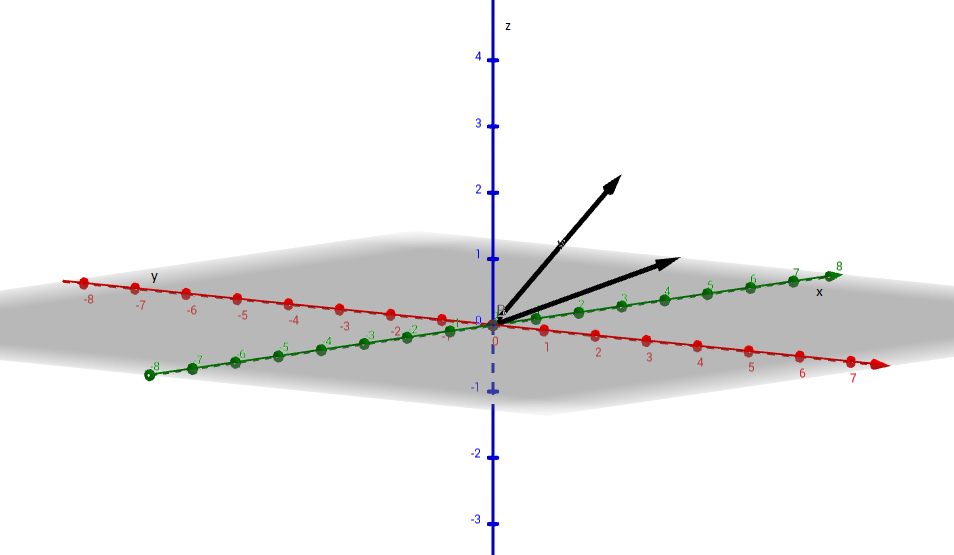Susan Colley Vector Calculus 4th Edition Chapter 1 Vectors
Page 7 Problem 1 Answer
Given : The vector(2,1)
To sketch : Vectors in R2
Evaluate to get the final answer
Indicated vectors are shown on the graph below :
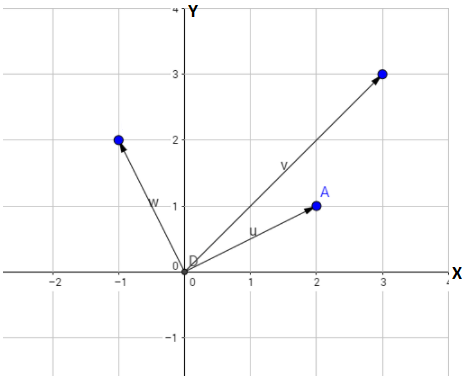
Therefore, the graph is plotted with the given value.
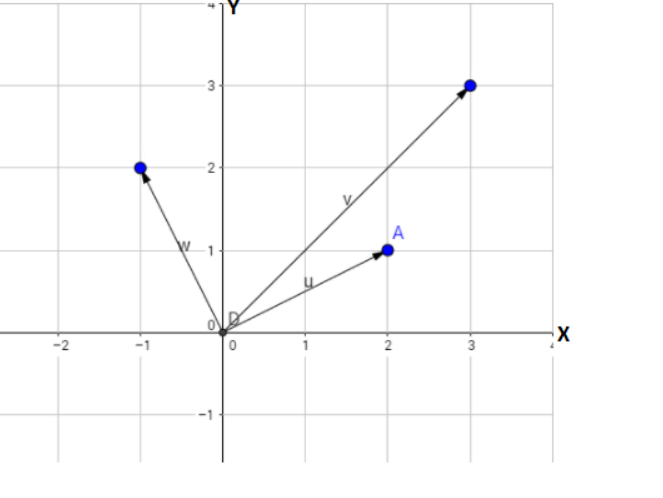
Page 7 Problem 2 Answer
Given : (3,3)
To find : Vectors in R2
Evaluate to get the final answer
Indicated vectors are shown on the graph below :
Read and Learn More Susan Colley Vector Calculus Solutions

Hence, the graph is plotted with given value.
Page 7 Problem 3 Answer
Given : (−2,1)
To find : Vectors in R2
Evaluate to get the final answer
Indicated vectors are shown on the graph below :
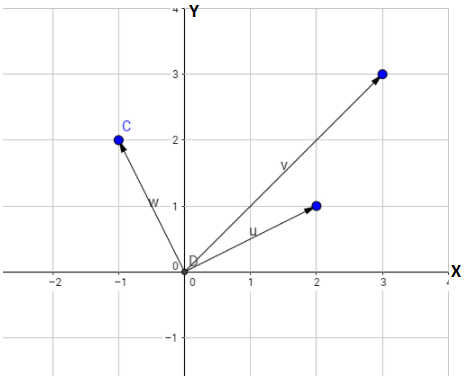
Hence, the graph is plotted with given value.
Page 7 Problem 4 Answer
Given : (1,2,3)
To find : Vectors in R3
Evaluate to get the final answer
Indicated vectors are shown on the below graph :
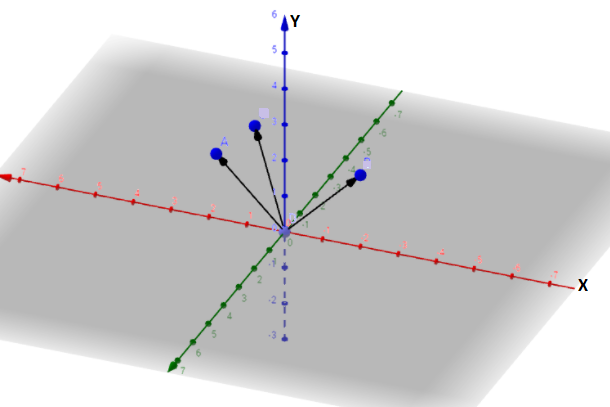
Hence, the graph is plotted with given values.
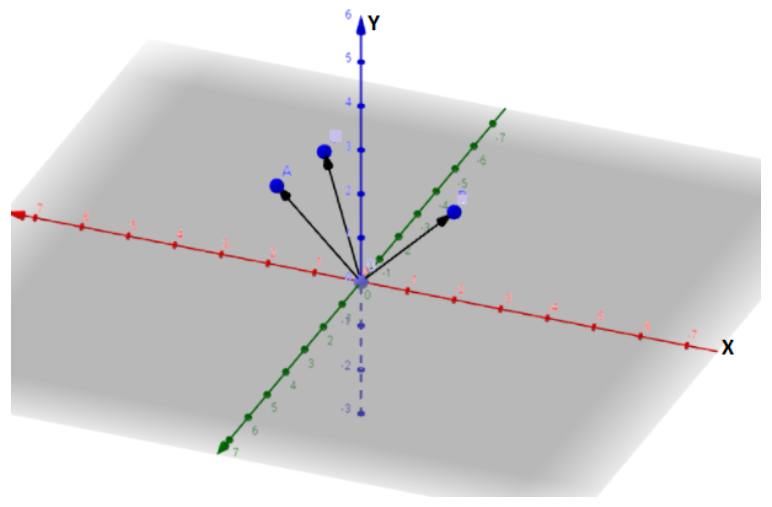
Page 7 Problem 5 Answer
Given : (−2,0,2)
To find: Vectors in R3
Evaluate to get the final answer
Given : (−2,0,2)
To find: Vectors in R3
Evaluate to get the final answer

Hence, the graph is plotted with given values.
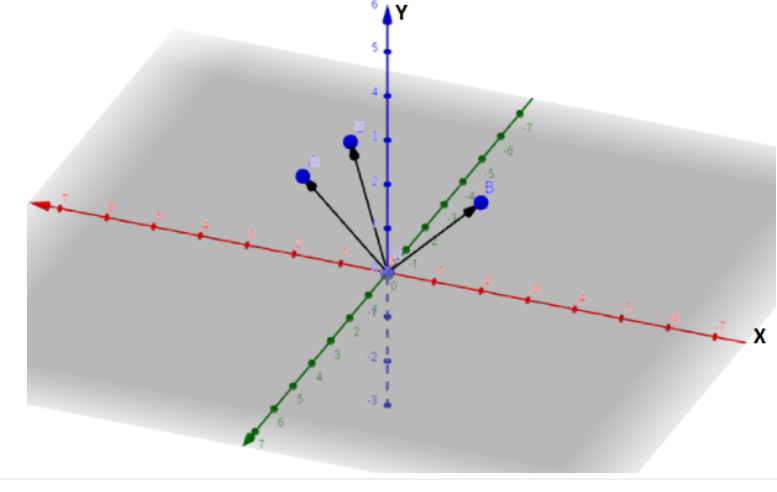
Page 7 Problem 6 Answer
Given : (2,−3,1)
To find : Vectors in R3
Evaluate to get the final answer
Indicated vectors are shown on the below graph :

Therefore, the graph is plotted with given values.
Page 7 Problem 7 Answer
Given : (3,1)+(−1,7)
To express: The given expression in single vector a=(a1,a2) in R2
Evaluate to get the required solution
Let us simplify in this way,
(3,1)+(−1,7)=(3−1,1+7)
=(2,8)
Hence, the required solution is (2,8)
Page 7 Problem 8 Answer
Given : −2(8,12)
To express: in the form of a single vector a=(a1,a2) in R2
Evaluate to get the final answer
Let us simplify in this way,
−2(8,12)=(−16,−24)
Therefore, the required solution is (−16,−24)
Page 7 Problem 9 Answer
Given : (8,9)+3(−1,2)
To express: In the form of a single vector a=(a1,a2) in R2
Evaluate to get the final answer
Let us simplify in this way,
(8,9)+3(−1,2)=(8,9)+(−3,6)
=(8−3,9+6)
=(5,15)
Therefore, the required solution is (5,15)
Page 7 Problem 10 Answer
Given : (1,1)+5(2,6)−3(10,2)
To find : Single vector a=(a1,a2) in R2
Evaluate to get the final answer
Let us simplify the equation in this way,
(1,1)+5(2,6)−3(10,2)=(1,1)+(10,30)−(30,6)
=(1+10−30,1+30−6)
=(−19,25)
Hence, the required solution is (−19,25)
Page 7 Problem 11 Answer
Given : (8,10)+3((8,−2)−2(4,5))
To find : Single vector a=(a1,a2) in R2
Evaluate to get the final answer
Let us simplify the equation in this way,
(8,10)+3((8,−2)−2(4,5))=(8,10)+3((8,−2)−(8,10))
=(8,10)+3(0,−12)
=(8,10)+(0,−36)
=(8+0,10−36)
=(8,−26)
Hence, the required solution is (8,−26)
Page 7 Problem 12 Answer
Given : (2,1,2)+(−3,9,7)
To find : Single vector a=(a1,a2,a3) in R3
Evaluate to get the final answer
Let us simplify in this way,
(2,1,2)+(−3,9,7)=(2−3,1+9,2+7)
=(−1,10,9)
Therefore, the required solution is (−1,10,9)
Page 7 Problem 13 Answer
Given : 1/2(8,4,1)+2(5,−7,1/4)
To find : Single vector a=(a1,a2,a3) in R3
Evaluate to get the final answer
Let us simplify in this way,
1/2(8,4,1)+2(5,−7,1/4)=(4,2,1/2)+(10,−14,1/2)
=(14,−12,1)
Therefore, the required solution is (14,−12,1)
Page 7 Problem 14 Answer
Given : −2((2,0,1)−6(1/2,−4,1))
To find : Single vector a=(a1,a2,a3) in R3
Evaluate to get the final answer
Let us simplify in this way,
−2((2,0,1)−6(1/2,−4,1))=−2((2,0,1)−(3,−24,6))
=−2(−1,24,−5)
Therefore, the required solution is (2,−48,10)
Page 7 Problem 15 Answer
Given : a=(1,2),
b=(−2,5), and
a+b=(1,2)+(−2,5)
To find: Parallelogram law and the head-to-tail methodEvaluate to get the final answer

Addition of vectors using parallelogram law.
Resultant vector is CD
Addition of vectors using head-to-tail method :
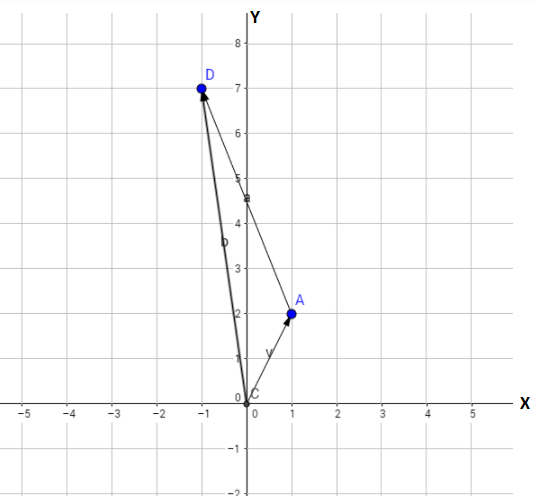
Therefore, the graph is plotted using parallelogram law and the head-to-tail method.

Page 7 Problem 16 Answer
Given : a=(3,2)
b=(−1,1)

To find: Calculate and graph a−b,1/2a, and a+2b
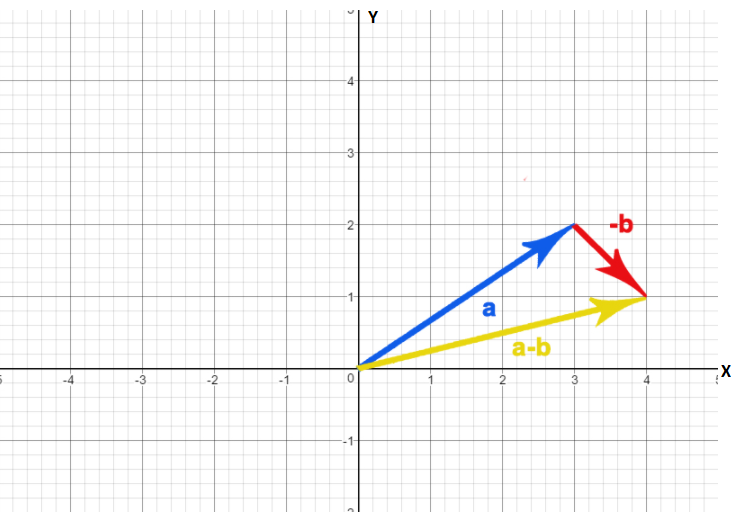
Evaluate to get the final answer

Hence, all the required graphs has been plotted.

Page 7 Problem 17 Answer
Given : Let A be the point with coordinates (1,0,2),let B be the point with coordinates (−3,3,1)
and let C be the point with coordinates(2,1,5)
To find : Vectors AB and BA
Evaluate to get the final answer
Each vector is determined with initial and terminal point.
That is, two points – one where it starts and one where it ends.
Vector AB starts at point A and ends at point B
Vector BA starts at point B and ends at point A.
Therefore,
Vector AB starts at point A and ends at point B and,
Vector BA starts at point B and ends at point A
Page 7 Problem 18 Answer
Given : Let A be the point with coordinates (1,0,2),let B be the point with coordinates(−3,3,1) and let C
be the point with coordinates(2,1,5)
To find : Vectors AC,BC, and AC+CB
Evaluate to get the final answer
Let us simplify,Vector AC starts at point A and ends at point C.
Vector BC starts at point B and ends at point C.
Vector AC+CB is sum of two vectors. Notice that first vector ends at point C and second vector starts at point C.
This means that the resulting vector starts at point A and ends at point B
Hence, we have described all the 3 given vectors.
Page 7 Problem 19 Answer
Given : Let A be the point with coordinates (1,0,2), let B be the point with coordinates (−3,3,1),and let C be the point with coordinates (2,1,5)
To find : Explain with pictures why AC+CB=AB
Evaluate to get the final answer
Let us plot a graph:

Hence, the vector is solved with the help of a picture.
Page 7 Problem 20 Answer
Given : (1,2,1) and (0,−2,3),
To find : Calculate and graph (1,2,1)+(0,−2,3),−1(1,2,1), and 4(1,2,1)
Evaluate to get the final answer

Let us calculate,
(1,2,1)+(0,−2,3)=(1,0,4)−1(1,2,1)
=(−1,−2,−1)
4(1,2,1)=(4,8,4)
Hence, we have calculated and graphed the given vectors.

Page 7 Problem 21 Answer
Given: The equation(−12,9,z)+(x,7,−3)=(2,y,5)
To find : Values of X,Y&Z
Apply addition of vectors to get the result.
Let us evaluate the given equation,
(−12,9,z)+(x,7,−3)=(2,y,5)
(−12+x,9+7,z−3)=(2,y,5)
(−12+x,16,z−3)=(2,y,5)
−12+x=2
So, we get
x=14
16=y
z−3=5
And, z=8
Therefore, the required values of X,Y and Z are 14,16 and 8.
Page 7 Problem 22 Answer
Given: The vector (3,1)
To find : What is the length (magnitude) of the vector (3,1)
Use Pythagorous theorem to get the length.
Given: The vector (3,1)
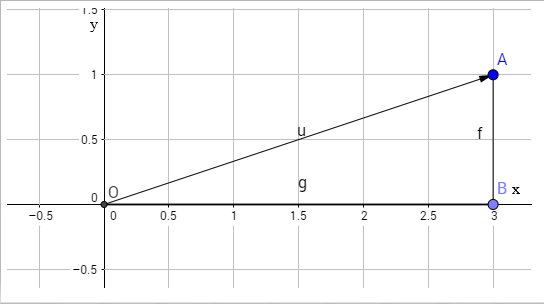
To find : What is the length (magnitude) of the vector (3,1)
Use Pythagorous theorem to get the length.
A vector from a origin to point (3,1)
The length of the vector is d=√32+12=√10
Therefore, the required length of the vector is √10.
Page 7 Problem 23 Answer
Given : The vectors, a=(1,2) and b=(5,10)
To sketch: The vectors and explain why they point in the same direction.
Explain with the help of a graph.
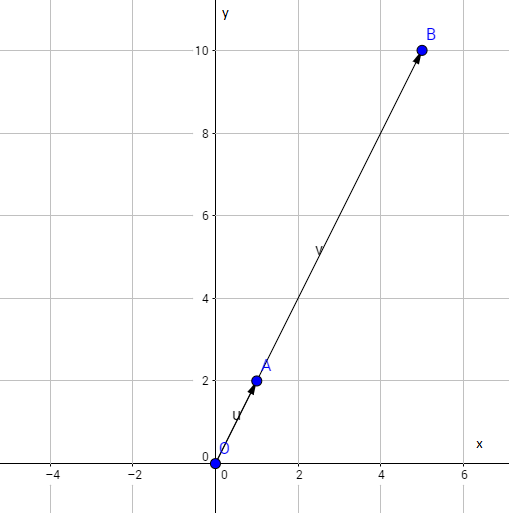
The graph of the given vectors a=(1,2) and b=(5,10)
As we see in the graph
It is true that a and b point in the same direction, because b is a multiple of a.
So, we can say that : b=5a
Hence, a and b point in the same direction ,because b is a multiple of a.
Page 7 Problem 24 Answer
Given : a=(a1,a2,…,an)
b=(b1,b2,…,bn) are two vectors in Rn and k ∈ R is a scalar.To find : Add the vectors (1,2,3,4)
and (5,−1,2,0) in R4 and the value of 2(7,6,−3,1)
Evaluate to get the final solution.
We add vectors in any dimension : (1,2,3,4)+(5,−1,2,0)=(6,1,5,4)
When we multiply with scalar, we multiply each component:
2(7,6,−3,1)=(14,12,−6,2)
So,(a1,a2,…,an)+(b1,b2,…,bn)=(a1+b1,a2+b2,…,an+bn)
k(a1,a2,…,an)=(ka1,ka2,…,kan)
Hence, the required solution is(1,2,3,4)+(5,−1,2,0)=(6,1,5,4)
And 2(7,6,−3,1)=(14,12,−6,2)
Page 7 Problem 25 Answer
Given : P1(1,0,2),P2(2,1,7)
To find: Displacement vectors from P1 to P2
To sketch : P1,P2, and P1/P2 .
Evaluate to get the final solution.
We can find displacement vector :
P1/P2=(x2−x1,y2−y1,z2−z1)
Where P1(x1,y1,z1) and P2(x2,y2,z2) are two points.
Let us solve now
P1/P2=(2−1,1−0,7−2)
=(1,1,5)
Hence, the required solution Is P1/P2=(1,1,5)
Page 7 Problem 26 Answer
Given : P1 (1,6,−1),P2 (0,4,2)
To find: Displacement vectors P1 to P2
To sketch : P1,P2 , and P1 /P2 .
Evaluate to get the final answer
We can find displacement vector as follows
P1/P2=(x2−x1,y2−y1,z2−z1)
Where P1(x1,y1,z1) and P2(x2,y2,z2)
Evaluating we get
P1/P2=(1−0,6−4,−1−2)
=(1,2,−3)
Hence, the required solution is P1/P2=(1,2,−3)
Page 7 Problem 27 Answer
Given : P1 (0,4,2),P2 (1,6,−1)
To find: The displacement vectors from P1 to P2
Evaluate to get the final answer.
We can find displacement vector :
P1/P2=(x2−x1,y2−y1,z2−z1)
Where P1(x1,y1,z1) and P2(x2,y2,z2)
We will do the evaluation now
P1/P2 =(0−1,4−6,2+1)
=(−1,−2,3)
Hence, the required displacement vector P1/P2
=(−1,−2,3)
Page 7 Problem 28 Answer
Given : P1(3,1),P2(2,−1)
To find : The displacement vectors from P1 to P2.
To sketch 😛1,P2 , and P1P2
Evaluate to get the final answer.
We can find displacement vector :
P1/P2=(x2−x1,y2−y1,z2−z1)
Where P1(x1,y1,z1) and P2(x2,y2,z2)
Evaluating we get
P1/P2=(3−2,1+1)
=(1,2)
Hence, the required displacement vector is P1/P2=(1,2)
Page 7 Problem 29 Answer
Given : P1 (2,5,−1,6) and P2 (3,1,−2,7)
To calculate : The displacement vector from P1 to P2
Evaluate to get the final answer.
We can find displacement vector :
P1/P2=(x2−x1, y2−y1, z2−z1)
Where P1(x1,y1,z1) and P2(x2,y2,z2)
We define displacement the same way as in R3.
So Displacement:
P1/P2=(3−2,1−5,−2+1,7−6)
=(1,−4,−1,1)
hence, the required displacement is P1/P2
=(1,−4,−1,1)
Page 7 Problem 30 Answer
Given : A is the point in R3 with coordinates (2,5,−6) The displacement vector from A to a second point B is (12,−3,7)
To find : Coordinates of B? Evaluate to get the final answer.
Let us find the coordinates of point B.
We can use displacement vector:
SupposeB=(x,y,z), then (12,−3,7)=(x−2,y−5,z+6)
Thus,
x−2=12
x=14
y−5=−3
y=2
z+6=7
z=1
Coordinates of B are: (14,2,1).
Hence, the coordinates of B are: (14,2,1).
Page 7 Problem 31 Answer
Given : Suppose that you and your friend talking on cellular phones.
You inform each other of your own displacement vectors.
To explain : How to determine the displacement vector from you to your friend.
Evaluate to get the final solution.
Let coordinate system represents origin.
Then, our displacements vectors coincide with our coordinates.
Thus, a⃗=A and b⃗=B.
Now, we find the displacement vector as
d⃗=B−A
Hence, the required displacement vector is d⃗=B−A
Page 7 Problem 32 Answer
Given: Properties 2 and 3 of vector addition.
To find : Give the details of the proofs of properties Two vectors can be added together by placing them together.
Let us evaluate
a+(b+c)=
=(a1,a2,a3)+((b1,b2,b3)+(c1,c2,c3))
=(a1,a2,a3)+(b1+c1,b2+c2,b3+c3)
=(a1+b1+c1,a2+b2+c2,a3+b3+c3)
=(a1+b1,a2+b2, =a3+b3)+(c1,c2,c3)
=(a+b)+c
Further evaluating,a+0=
=(a1,a2,a3)+(0,0,0)
=(a1+0,a2+0,a3+0)
=(a1,a2,a3)
=a
Hence, we have given the details of the proofs of properties 2 and 3 of vector addition(a+b)+c.
Page 7 Problem 33 Answer
Given: Properties of scalar multiplication
To prove : The properties of scalar multiplication Evaluate to get the final answer.
We can prove this as follows
k(la)=k(la1,la2,la3)
=kl(a1,a2,a3)
=(kl)a
=(lk)a
=l(ka)
Hence, we have proved the properties of scalar multiplication.
Page 7 Problem 34 Answer
Given: A vector a in R2 or R3.To Find: Calculate the value of 0a and prove the answer.
By doing scalar multiplication of vector a, we can calculate the value.
Firstly,0a is zero vector in R2 or R3 depending on where a came from.
A zero vector is a vector having a magnitude of zero.
Now,
0a=0(a1,a2,a3)
⇒0a=(0⋅a1,0⋅a2,0⋅a3)
0a=(0,0,0)
Therefore, 0a is a zero vector having magnitude 0.
Page 7 Problem 35 Answer
Given: A vector a in R2 and R3.To Find: The value of 1a
and prove the answer. By doing the scalar multiplication, we can calculate the value.
From Scalar multiplication, we know that the value of 1a is a.
Now,1a=1(a1,a2,a3)
⇒1a=(1⋅a1,1⋅a2,1⋅a3)
⇒1a=(a1,a2,a3)
∴1a=a
Therefore, the required value of 1a is a.
Page 7 Problem 36 Answer
Given: A vector x=sa+tb where 0≤s≤1 and 0≤t≤1,along with the coordinates of a and b.
To Explain: The reason for vector x lying in the parallelogram determined by a and b.
A sketch of the vectors described will help in determining the answer.

A simple sketch explains why the vectors of the described set are in fact a parallelogram.
The most distant point from (0,0) you can reach with vectors a and b is exactly the end point of vector g=a+b.
On the other hand, using any other, smaller coefficients on a and b will land the new vector somewhere inside or on the edge of parallelogram depending on what coefficients we use.
For example, vector 0.5a+0.2b will be inside of parallelogram since both coefficients in front of a and b are smaller then l.
On the other hand, vector 0.5a+b will have it’s end point on the edge of parallelogram since the coefficient in front of b is equal to 1.
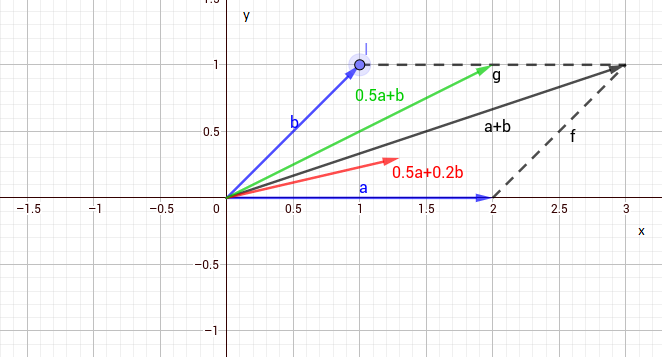
Therefore, we have explained the reason for x lying in the parallelogram determined by a and b.
Page 7 Problem 37 Answer
Given: A set of vectors, {x=sa+tb∣0≤s≤1,0≤t≤1} along with the coordinates of a and b.
To Describe: The set of vectors, {x=sa+tb∣0≤s≤1,0≤t≤1}.
From the coordinates of a and b, we know that the given vector is in 3-D, so we can explain accordingly.
The explanation is similar to the part a) of the task.

The only difference is that we now have two vectors in 3-D space.
However, any linear combination of these two vectors with the coefficients being between zero and one will again yield a parallelogram, but this time in three dimensional space.
Therefore, we have described the given set of vectors.
